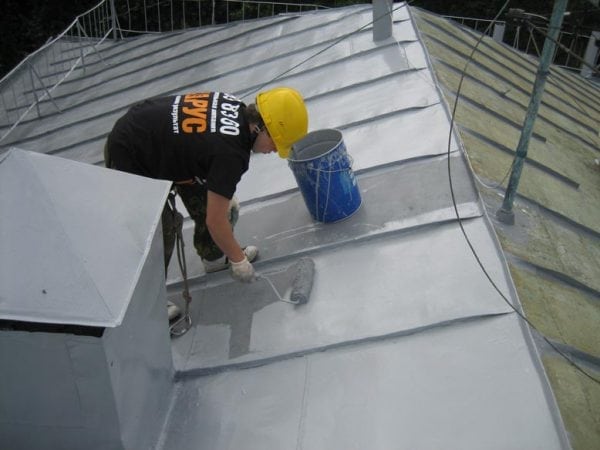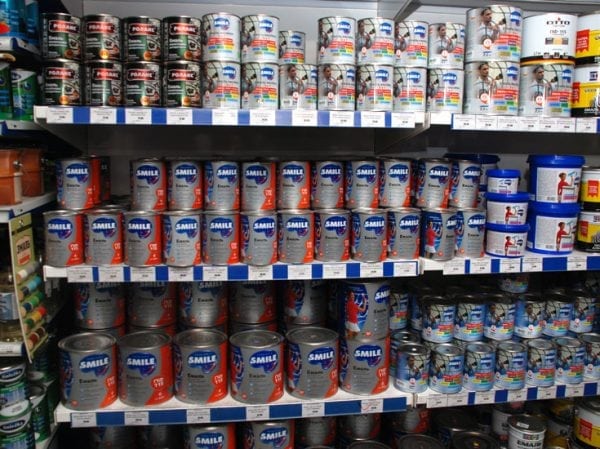The roof is a part of the house that is exposed to a particularly intense influence of aggressive external influences. Precipitation will very soon lead to the development of corrosion processes if metal is used as a roof covering. That is why unprotected metal surfaces cannot be used in roofing structures.
- Staining purposes
- Paint selection
- Famous Brands Overview
- Hammerite
- Tikkurila
- Tsikrol
- Other formulations
- Surface preparation
- Paint application

One of the obvious solutions to protect the metal is to apply a zinc layer to it. However, as practice shows, even such a material eventually inevitably undergoes corrosion, which leads to the gradual destruction of the material. To fix the situation, roofing paint on galvanized iron will help.
to contents ↑Staining purposes
Even at the factory, galvanized sheets are covered with an oil layer that protects the metal from environmental factors. However, most often within a year and a half, the layer gradually disappears, due to precipitation. That is why galvanizing is recommended to be painted. This approach will solve the following problems:
- Corrosion protection.
- The appearance of the roof will become more attractive, especially since the color can be selected in accordance with the style of the building.
- Despite the fact that the painting costs money, the financial costs in this case will still be less than if you have to change the roof before the planned date.
Paint selection
When choosing a coloring composition, some features of the roofing material must be taken into account, among which:
- Compatibility. Since zinc belongs to the group of metals with a high level of chemical activity, far from any paint can be used for its coloring. An improperly selected composition will react with zinc, which will lead to destruction of the structure. Based on this circumstance, the paint should be selected chemically inert, not causing adverse reactions with this metal.
- Elasticity. Since the roof is constantly exposed to ultraviolet radiation, the roof material expands, and this can lead to a violation of the integrity of the paint layer in case of insufficient elasticity. Therefore, elasticity is a mandatory requirement not only for zinc, but also for any other roof.
- Wear resistance. The roof is regularly exposed to mechanical factors: rain, hail, snow masses, accumulated debris, etc. In addition, the coating must be resistant to abrasion.
To the greatest extent listed properties are characterized by acrylic compositions. They are distinguished by strength, elasticity, and wear resistance. The main disadvantage of acrylates is the high cost.
to contents ↑Famous Brands Overview
Consider the advantages and disadvantages of coloring compositions for zinc from among the brands popular on the market.
Hammerite
The advantages of paint include the following qualities:
- the possibility of applying directly to a rusted area;
- coatings are characterized by wear resistance and long service life;
- good adhesion;
- anticorrosion resistance;
- attractive appearance of the coating and rich colors;
- short drying time;
- resistance to ultraviolet radiation.
Disadvantages:
- Potential risk of salt deposition.
- Insufficient rust resistance (first traces of corrosion may appear after 3-4 years).
- Poor degreasing usually causes cracking of the coating.
- If you use a roller, air bubbles may form.
Tikkurila
The positive characteristics of the paint generally coincide with Hammerite, however, the composition of this brand has additional advantages:
- Higher resistance to aggressive environmental factors, including exposure to humidity and chemicals.
- Thermal stability (the coating can withstand temperatures up to 80 degrees above zero), thanks to which the paint not only does not collapse in the heat, but also adheres more strongly to metal.
- LKM from this Finnish producer perfectly tolerates low temperatures.
Tsikrol
This acrylic composition has a matte finish. The advantages of the paint include the following characteristics:
- the presence of special additives against rust;
- moisture resistance;
- good adhesion to galvanization;
- spreadability uniformity;
- there is no need for priming the metal before painting;
- frugality, as one layer of paint is enough;
- the coating does not fade;
- the painted surface dries quickly;
- frost resistance.
Other formulations
Below, we briefly list the features of several more Russian-made coatings:
- "Unicom." The main feature of this paint from a Russian manufacturer is fire resistance. Unikom is used for coatings subject to high thermal stresses.
- Serebrol. This paintwork material is a one-component anti-corrosion enamel. Paint can be used both for galvanized roofs and for steel surfaces. At the heart of the paint is aluminum powder, which increases the protective parameters of the composition. In addition, LKM includes resins (perchlorovinyl and epoxy), as well as special additives and an organic solvent. In addition to corrosion resistance, Serebrol is characterized by resistance to moisture, mechanical damage, and the effects of chemicals (such as oils and gasoline).
- "Rostex Super." Refers to specialized primers for galvanized surfaces. The primer is used not only to protect the roof, but also various pipelines (ventilation, water flow).
Surface preparation
First of all, it is necessary to prepare the metal for painting. We start by removing the old paint layer. For this we use special chemical washes. These chemicals allow you to clean the surface without serious mechanical effort. Traces of corrosion can be carefully removed with a wire brush or, more preferably, with a rust converter.
Important! The rust converter will somewhat slow down the progress of the work, because after applying it to the galvanized surface, you will have to wait for its effect to occur for 3-5 days.
When the metal cleaning is complete, degrease the material with white spirit or a similar composition. This will increase the ability of the metal to adhere to the paint. It should be noted that this event is not necessary if an acrylic composition will be applied in the future, however, if the roof is not very clean, degreasing is not recommended.
to contents ↑Paint application
Staining is most often done with a roller or a wide brush. The roller is better suited for processing large and even areas. A brush is useful for processing small parts. Work with a brush allows you to get a more even coating. You can use a spray gun if you have the skills to handle this equipment.
The optimum temperature of the material to be painted is from 10 to 40 degrees above zero. Humidity should not exceed 75-80%. It is undesirable to paint on hot summer days, since too hot a substrate will cause uneven polymerization.
Before starting work, the paintwork material should be well mixed, and this should be done periodically and then during the work process. If an aerosol can is used, it must be shaken for 20-30 seconds before starting work.
Paint is applied in two to three thin layers. If the layers are too thick, drips will appear. Each subsequent layer can be applied only after polymerization of the previous one. Drying time is indicated by the manufacturer on the packaging.










